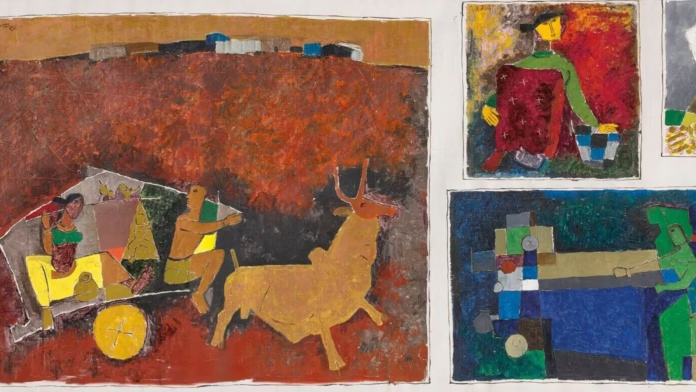When legendary artist M.F. Husain’s 14-foot canvas Gram Yatra sold for a staggering USD 13.7 million (~₹118.7 crore) at Christie’s in New York, it didn’t just break records—it ignited a conversation. A proud milestone for Indian art, yes, but also a reminder that global recognition is still limited to a select few iconic names.
This sale, which now holds the record for the most expensive Indian modern artwork ever auctioned, comes just months after Amrita Sher-Gil’s The Story Teller fetched USD 7.4 million. Together, these headlines suggest a new era for Indian art—but scratch beneath the surface, and you’ll find a market still deeply skewed toward a small circle of masters.
The Stars Are Shining, But What About the Sky?
India’s top auction numbers in 2024 crossed ₹1,559 crore, a 21% rise over the previous year. But the surge is driven by the usual titans: F.N. Souza, S.H. Raza, Ram Kumar, and of course, Husain.
In fact, according to Artprice’s 30th Annual Report, F.N. Souza outpaced Salvador Dalí in auction turnover—an impressive feat. Yet as artist and author Anurag Anand notes, this isn’t the full picture.
“It’s like a cricket team where only the star players get to bat,” says Anand. “There’s talent warming the bench, but not enough support to bring them into the spotlight.”
One Exhibition, Many Possibilities
Change, however, is quietly unfolding. A recent exhibition in New Delhi curated over 100 works tracing the evolution of Indian art across a century—bridging the gap between past legends and emerging voices.
From modernists like K.H. Ara, G.R. Santosh, F.N. Souza, to senior contemporaries such as Manu Parekh, Anjolie Ela Menon, and exciting new talents like Shanaka Kulathunga and Jitendra Dangi, the exhibition showcased a rare harmony across generations.
Two works particularly stayed with Anand:
-
Anita Roy Chowdhury’s poignant 2008 painting of a mother holding a child—raw, intimate, and deeply human.
-
Sunil Das’s 1992 portrait of a skeletal woman, her gaze piercing the viewer, whispering existential questions through smudged hues and symbolism.
These moments underline a truth: the soul of Indian art lies not just in prestige, but in emotion and experimentation.
What Comes After the Masters?
Today, India’s art market is booming, but it’s still largely elitist and uneven. While names like Husain and Raza headline global auctions, young and contemporary artists struggle for visibility and validation.
To truly build a global identity, India needs more than auction records—it needs platforms, access, and mentorship.
Anurag Anand puts it best:
“There might never be another Husain. But there are artists today whose voices deserve to be heard—whose canvases tell stories just as rich. We just need to listen.”
Looking Ahead
The early sales trend from the Delhi exhibition revealed something hopeful—buyers were investing in both established and emerging artists. That’s the direction the Indian art scene needs: balanced, diverse, and future-focused.
Indian art has arrived on the global stage. Now it’s time to widen that stage and invite more players in.







